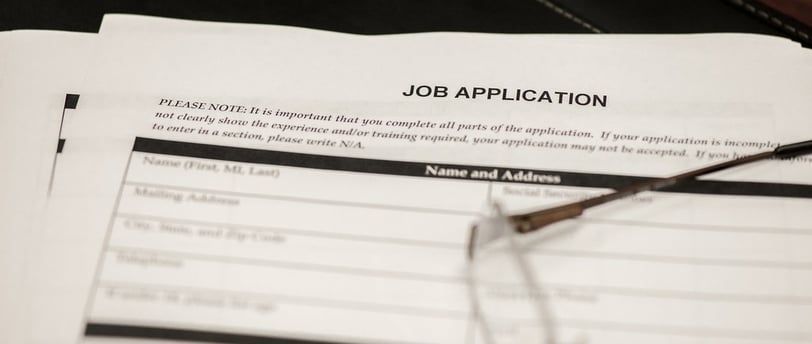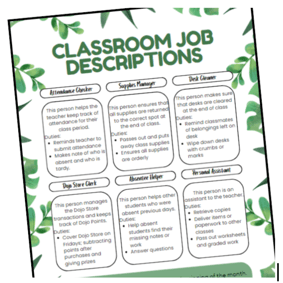I Started Classroom Jobs in my Secondary Classroom - and Here’s What Happened
When designing my classroom management plan, I never considered using classroom jobs. Jobs are for elementary students, not secondary, right? Read to find out how and why I changed my opinion on jobs in the secondary classroom!
1/15/20254 min read


Classroom management is a constant struggle for all teachers. There is an abundance of advice and strategies out there, but so many of them seem unrealistic or ineffective!
Many of my elementary teacher colleagues used classroom jobs to organize their classroom. I thought this was great for them, but never even considered it for my middle school and high school students. I thought classroom jobs were “too childish” for my students, and I doubted my students would feel motivated to do them.
This year, I started classroom jobs in my classroom and they have been a LIFESAVER! Here’s how:
Why I Started Classroom Jobs
As much as I would love to tell you that I am an organized type-A teacher, that is not my reality. Take one look at my desk or classroom closet and you will see that I am just as scatterbrained as my middle school students!
Weeks into the school year, I started to feel the overwhelming stress of trying to complete all of the tasks I needed to do in a day. Take attendance, send lunch count, update tardies, remind students about due dates, check and clean up the supplies, grab extra copies, catch up students who missed a day, clean the desks, and of course, teach. I was falling behind in many of these areas and struggling to keep up. While I occasionally remembered to ask students for help, they rarely had the motivation to try.
I realized that I needed to intentionally delegate my responsibilities, just like any good manager would do! This began my classroom jobs.
How I Set Up the Jobs
The first step to setting up my classroom jobs was determining what needed to be done. In my classroom, I needed the most help with taking attendance, managing classroom supplies, cleaning desks, catching up absent students, running the classroom store, and keeping up with the little errands that came up throughout the day (extra printouts, passing back papers, etc.).
Once I determined what I needed help with, I created job titles and descriptions. My job titles included Attendance Checker, Supplies Manager, Desk Cleaner, Store Clerk, Absentee Helper, and Personal Assistant.
If you are interested in my classroom job description template, check it out here!
The next step was figuring out how to motivate my students. In my classroom, I use a Dojo Point behavior management system, which I plan to write about soon. Students earn Dojo Points for positive behaviors which they can use as currency in our classroom store. I decided to “pay” the students with classroom jobs a certain number of Dojo Points a week as motivation.
Finally, I had to figure out how to roll out the jobs. I decided to create job applications to tie in some real world connections. Students could choose to apply for a job or not. In their application, they included their first and second pick, as well as the reason they think they would be the best fit for the job. I decided to reopen the job applications at the beginning of the month to give students a chance to change their jobs.
The Outcome
I’ll be honest, I was doubtful that my jobs would work. I worried that students would be unmotivated to help me as they had been in the past. Who would want to do MORE work in class? Thankfully, I was very wrong.
Once I introduced classroom jobs, my students became interested in the various positions (and the pay). I gave each class the option to do jobs, and all but one class did (my oldest students, sophomores). I was surprised to receive the most enthusiastic response from my freshman students!
Within the first day, I received many applications, with the most applications going towards the Personal Assistant and Store Clerk positions. I chose the students with the strongest reasoning in their application and announced positions the next day. Students were excited to start their jobs and eager to complete their tasks each day. I had students staying after class to wipe desks and clean up pencils, and my personal assistants were offering to get my copies and pass out the paperwork. My attendance checkers made sure I was submitting attendance each day and the absentee helpers caught up returning students.
While my first month of jobs went great, I figured my students would quickly get burnt out. However, the next month of jobs had even more applications than the first round! Students vied for positions and were already planning what their applications for the next month would say.
Overall, classroom jobs have strengthened both my teaching and my classroom community. Not only is my attendance turned in on time, but my students also value our class and the role they play in it. Multiple students expressed their wish to have a purpose in class, with one of my students even explaining that becoming an attendance checker would encourage them to come to class on time! Classroom jobs helped students feel a sense of responsibility and importance.
I will continue using classroom jobs in my secondary classroom, and I hope you will too!


